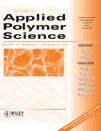Modeling the stress-relaxation behavior of wool fibers
Abstract
The stress-relaxation behavior of wool fibers after a pretreatment with a chemical solution is particularly important for evaluating the efficiency of the pretreatment. In this study, three viscoelastic models, including the Maxwell, two Maxwell unit, and modified two Maxwell unit models, were established first. To verify the feasibility of the models, stress-relaxation experiments for wool fibers were performed. The wool fibers were pretreated with a sodium bisulfite solution (1 and 3%) at various temperatures (293, 298, 303, 308, 313, and 318 K). Then, the experimental values were fitted to the three models to obtain the rate constants of relaxation. The activation energy of the wool fibers was calculated with the Arrhenius equation. The results showed that the modified two Maxwell unit model provided the best fit for the experimental data of the wool fibers. The stress-relaxation process of the wool fibers could be divided into two stages, a rapid stage followed by a slow stage. The rapid relaxation of stress was attributed to the weak bonds in the wool fibers, and the following slow relaxation stage was attributed to strong bonds. The Arrhenius equation could describe the stress-relaxation process of the wool fibers very well. Furthermore, the activation energy decreased in the presence of sodium bisulfite. © 2008 Wiley Periodicals, Inc. J Appl Polym Sci, 2008




